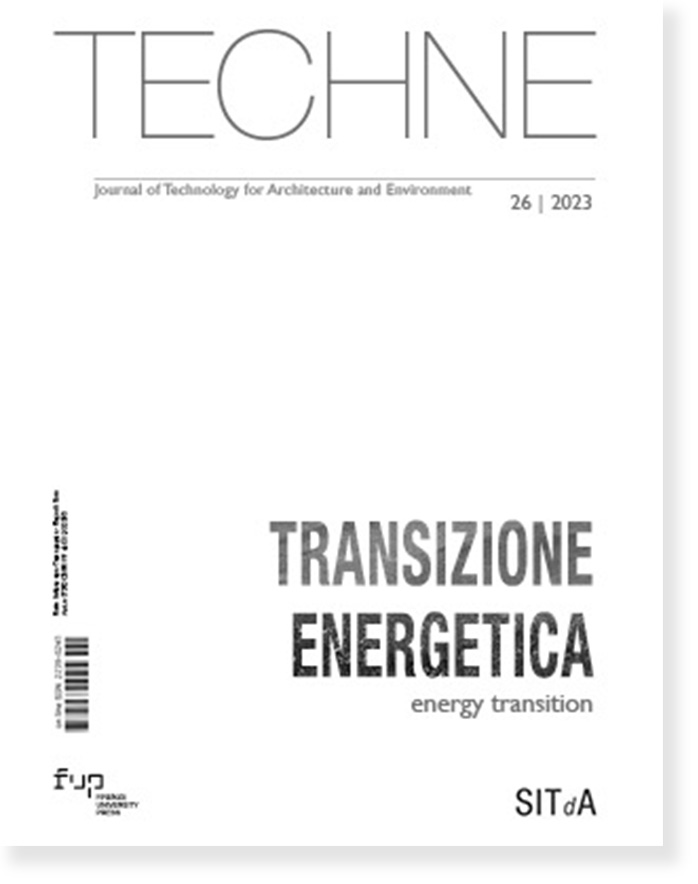Published 2023-10-31
Keywords
- Community,
- Energy,
- Equipment,
- Infrastructure,
- Network
How to Cite
Copyright (c) 2023 Mattia Federico Leone, Roberta Amirante, Antonio Sferratore

This work is licensed under a Creative Commons Attribution 4.0 International License.
Funding data
-
European Commission
Grant numbers 1011056841
Abstract
Three years after their establishment in the Italian regulatory framework, the Renewable Energy Communities (CERs) can be an important resource for architectural and urban design, combining decarbonisation and climate resilience objectives with the provision of new public spaces and social services, the reduction of energy poverty and the dissemination of a new environmental culture. In such a setting, the production networks spread over buildings and elements of urban equipment are connected to the new central venues constituted by the hubs, the heart of the community. Starting from the case study of the San Giovanni a Teduccio district in Naples, the Horizon Europe KNOWING project aims to define a replicable model to support a strategic vision for 2050.
Downloads
References
Bidmon, C.M., Knab S. (2018), The three roles of business models for socio-technical transitions. New linkages between business model and transition research, Journal of Cleaner Production, 178, 903-916.
Checchi A., Egenhofer C., Behrens A. (2009), Long-Term Energy security Risks for Europe. A Sector-Specific Approach, CEPS n. 309.
Cattini, A. (2021), “Un immaginario per guardare oltre la crisi climatica”, Duegradi, 1 March, available at: https://www.duegradi.eu/news/crisi-immaginario/ (accessed 15 December 2021].
Gjorgievski, V. Z., Cundeva, S. & Georghiou, G. E. (2021). Social arrangements, technical designs and impact of energy communities: A review. Reneable Energy, 169, 1138-1156.
European Commission (2019), European Climate Law, Document 32021R1119, PE/27/2021/REV/1
European Commission (2019), The European Green Deal, Document 52019DC0640, 640 final.
IPCC (2021), Climate Change 2021: The Physical Science Basis. Contribution of Working Group I to the Sixth Assessment Report of the Intergovernmental Panel on Climate Change, Cambridge University Press, Cambridge, United Kingdom and New York, NY, USA
IPCC (2022), Climate Change 2022: Impacts, Adaptation, and Vulnerability. Contribution of Working Group II to the Sixth Assessment Report of the Intergovernmental Panel on Climate Change, Cambridge University Press, Cambridge, UK and New York, NY, USA, 3056
Langer, A. “La conversione ecologica potrà affermarsi solo se apparirà socialmente desiderabile”, available at: https://www.alexanderlanger.org/140 (accesso 22/12/2023).
Law J., Callon M. (1992), The life and death of an aircraft: a network analysis of technical change, Bijker W, L. J., Shaping technology, building society, Massachusetts, MIT Pres, 21–52.
Pone, M. (2019), Architetture devianti. Il potenziale infrastrutturale dell’architettura, in Ricerca in Vetrina 2018. Ricerca è democrazia. Il ruolo dell'attività scientifica nella costruzione di un futuro equo e sostenibile. ISBN: 9788891772152, available at: https://hdl.handle.net/11590/362167
Raven, R., Heiskanen, E., Lovio, R., Hodson, M., Brohmann, B. (2008), The Contribution of Local Experiments and Negotiation Processes to Field-Level Learning in Emerging (Niche) Technologies Meta-Analysis of 27 New Energy Projects in Europe. Bulletin of Science, Technology & Society, 28, 464-477.
Riva, R. (2020), “Il progetto del paesaggio nell’interazione tra natura e cultura: il ruolo generativo della comunità”, in Perriccioli, M., Rigillo, M., Russo Ermolli, S. and Tucci, F. (Eds.), Design in the Digital Age. Technology, Nature, Culture, Maggioli, Santarcangelo di Romagna, Italia, pp. 96-98.
Leone, M. F., Raven, J. (2018), "Multi-scale and adaptive mitigation design methods for climate resilient cities”, in TECHNE: Journal of Technology for Architecture and Environment, 15, June 2018, pp. 299
Losasso, M. (2022), “Crisi interconnesse e complessità del progetto” in TECHNE: Journal of Technology for Architecture and Environment, 23, May 2022, pp. 7-9
Legambiente (2022), Comunità Rinnovabili 2022.
Slee, B. (2014). Is there a case for community-based equity participation in Scottish on-shore wind energy production? Gaps in evidence and research needs. Renewable and Sustainable Energy Reviews, 41, 540-549.
St. Denis G., Parker P. (2009), Community energy planning in Canada: the role of renewable energy. Renew Sustain Energy Rev., 13, 2088-95.
Van der Schoor, T., Schlotens, B. (2014), Power to the people: Local community initiatives and the transition to sustainable energy. Renewable and Sustainable Energy Reviews, 43, 666-675.






